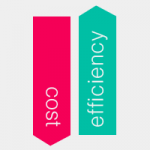Speaking of methods to reduce costs, increase sales and optimize the results of insurance, we usually come to the following question – “If we invest in these directions, would the effect ultimately be positive?“ Undoubtedly, one of the effective methods to reduce costs would be a modern, high-technology online platform for sales and management of insurance contracts. Nowadays, businesses are aware of the advantages of this type of technology. But it would be good, if we are able to predict to some extent what results will be obtained after the deployment of new technology.

In this article, which is divided into three parts, we are exploring a hypothetical example, which is not so far from reality. We are constructing several simulation scenarios and then we are measuring results that are directly dependent on some parameters change. These parameters are changing due to successfully implemented method for optimization of the results and efficiency in expenditure.
In the current first part we introduce the fundamentals of our model and then we measure the results of two parallel scenarios – one with initial values of parameters taken from some published statistics, and one with both reduced costs and prices compared to these initial values. The second part shows theoretically the reasons for the differences in the results of the two scenarios and studies the development of the second scenario under different assumptions of price elasticity of demand. In the third part, there is represented and analyzed a third scenario – in this scenario another strategy for allocation of savings from reduced costs is chosen.
Let us take the example of Motor third-party liability insurance (MTPL). This insurance would represent a fitting product for online sales as it is partially harmonized by the EU Motor Insurance Directive (MID), also widespread and recognizable by consumers. This helps its expedite implementation on an online platform on one hand, and the easy purchasing of insurance policies by consumers on the other. In our research, we will use some data from the report “European Motor Insurance Markets”, published on November, 2015, by the European Insurance and Reinsurance Federation. The data published in the report cover a period of 10 years (2004-2013), but we will use the most recent – those for the year of 2013. According to these data the claims ratio amounted to 80% of earned premiums (average for the European market), and 22.7% of written premiums are estimated as operating costs, representing the sum of the acquisition costs and administrative expenses. The European Insurance and Reinsurance Federation measures an amount of 102.7% for the combined ratio for 2013, which indicates inadequacy of premiums. According to the report of Morgan Stanley and The Boston Consulting Group (BSG) in September, 2014, entitled “Insurance and Technology – Evolution and Revolution in a Digital World”, 21% reduction of combined ratio could be achieved due to use of modern information technologies, including online platforms for selling of insurance policies. This analysis gives us an opportunity to do a simulation of a simplified model, that will provide some cost reduction upon successful implementation of new technology for dealing of insurance policies in a fully digital way.
So, let us introduce the fundamentals of our model. Suppose we manage an insurance company, which achieved sales of 100 units of daily premium for one-year-long MTPL insurance policies. We assume that sales are made on 17.4% acquisition costs and 5.3% administrative expenses – totally, operating costs represent 22.7% of premiums. In this simplified setup we can easily calculate some key financial indicators. So, at the end of the financial year we will have realized Gross Written Premium (GWP) amounted to 36500 units of currency, respectively acquisition costs – 36500 * 17.4% = 6351 units and administrative expenses – 36500 * 5.3% = 1934.5 units. The values of the Unearned Premium Reserve (UPR) and Deferred Acquisition Costs (DAC) also can be easily calculated. We need to obtain the value of the UPR, and that of the DAC represents 17.4% of the UPR. Let’s look at how much of the premium written in each of the days remains unearned at the end of the financial year. (See (1))
(1) Value of UPR at the end of the financial year
|
DAY |
Value of UPR at 100 units of daily premium written |
COMMENT |
|
1 |
0/365*100 |
The whole premium written during the first day becomes earned at the end of the year. |
|
2 |
1/365*100 |
1/365 of the premium written during the second day remains unearned at the end of the year. |
|
3 |
2/365* 100 |
2/365 of the premium written during the third day remain unearned at the end of the year. |
……………………………………………………………………………………………………………………………………………………
|
364 |
363/365* 100 |
363/365 of the premium written during the 364th day remain unearned at the end of the year. |
|
365 |
364/365* 100 |
364/365 of the premium written during the last day remain unearned at the end of the year. |
It is now easy to see that UPR as a part of the annual GWP is displayed by the following formula:
It should be noted that according to the model, at the end of the financial year there could not be any unearned premiums left from previous years, nor UPR as a part of premiums written in previous years, and that is because the contracts are annual.
Now we can easily calculate DAC too, which is 18200 * 17.4% = 3166.8 units of currency.At the year end, these terms stand with the following form on the balance sheet:
(2)
|
GWP |
36500 |
6351 |
Acquisition Costs (AC) |
|
DAC |
3166.8 |
18200 |
UPR |
|
|
|
1934.5 |
Administrative expenses (AdC) |
In calculating the portion of the technical result, formed by the observed components, we will take into account the values of the UPR and DAC at the end of the previous year, which are same as current ones, ceteris paribus. The general formula for the result sought is as follows:
(3)
,
where indices y1 and y0 indicate the values of components respectively at the end of the current financial year and at the end of the previous one.
Substituting in the formula, we obtain:
This is a part of the technical result, formed by the considered components, which value is same each year under the condition of sustainability of the model parameters., i.e.
.
Of course, when calculating the total technical result of a product there are more variables involved, but we focus on the effects of our 5 components on the total technical result. We assume that the other components are independent of those 5 and sustainable, i.e. remain constant over time, including when changing certain parameters in the model. In the above-mentioned report of Morgan Stanley and Boston Consulting Group, along with reducing operating costs using information technology, it is forecasted a beneficial effect on the claims ratio (as they would be built quality mechanisms for risk assessment and prevention harboring or replacement of essential risk information), which would improve further results from insurance, but this aspect is not considered in the current approach.
The above calculations are derived based on assumptions relating to the sustainability of the model and its parameters for the last two years (previous and current). Let us now „play“ a parallel scenario growing under the following conditions: At the beginning of the current year, we successfully launched a new platform for management of the underwriting process and sales of MTPL insurance policies, entirely digitally. As a result we ascertain 5% reduction of acquisition costs and another 2% reduction of administrative expenses. Obviously, in this situation and if we do not change other circumstances, the result at the end of the current year will be much better compared to the first scenario growing, as we have cut back costs significantly. Let though it calculate:
,
which is 1645 units more than the result achieved by the initial values of the parameters.
But let’s make our model more interesting. In general, it is expected that the increase in quality and the reduction of the costs of a production through the use of modern and efficient technologies, should lead to cheaper and better products for the whole society, and not all assets of increased effectiveness to remain fully encapsulated in the relevant industry. In the case of insurance business, cost reduction without reducing the price may lead to unreasonably high levels of risk premiums, and to unsatisfactory competitive positions compared to other market competitors that also benefited from the technology.
So let us give the end consumer all the cost savings as a “gift” in our parallel scenario. This means that we reduce the price of policies exactly as much as we have reduced the operating costs. We assume that all other model parameters remain unchanged, also during the first year of the change will maintain the same level of sales volumes, despite the lower price of the insurance policies.
All this will have the following impact on the model: Every day during the current year the insurance company will achieve sales of 93 units at the following levels of operating costs:
(4)
This means that after the change, 15.7% operating expenses (AC + AdC) of old (not reduced) premium is equivalent to approximately 16.88% of new, reduced premium, i.e. we reduce the price of policies while preserving the absolute value of operating costs.
In the approved manner and according to (1) we compute the values of the observed variables at the end of the year, under the new conditions:
At these values, balance would look like this:
(5)
|
GWP |
33945 |
4526 |
Acquisition Costs (AC) |
|
DAC |
2256.8 |
16926 |
UPR |
|
|
|
1204.5 |
Administrative expenses (AdC) |
So, for the part of the technical result formed by these components, according to (3) we obtain:
And we get a very curious result! We cut back premium and costs with the same absolute value, but instead of having the same result at the end of the year we have 364 units of currency more, which is an increase of 1.29% provided that other parameters retain their values.
In the next part, by parameterizing our model, we will find the theoretical reason for the difference between the development of the two scenarios, as well as the parameters that form this difference. Then we are going to study the further development of the second scenario under several assumptions about the level of price elasticity of demand.
1 Numbers may not add up due to rounding.



